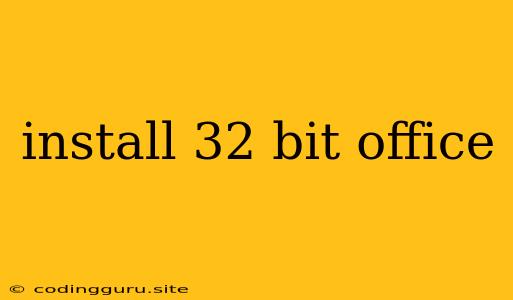Want to Install 32-bit Office on Your Computer? Here's What You Need to Know
Many users prefer 32-bit applications for a variety of reasons, like compatibility with older programs or limitations in hardware resources. If you find yourself needing to install 32-bit Office on your system, this guide will help you navigate the process.
Why Choose 32-bit Office?
Here's a quick breakdown of why someone might choose 32-bit Office over the 64-bit version:
- Compatibility: Some older programs or add-ins might not be compatible with 64-bit versions of Office.
- Resource Management: If you have limited RAM or a less powerful computer, the 32-bit version might run smoother.
- Legacy Systems: If your computer is running an older operating system that doesn't fully support 64-bit applications, 32-bit Office might be the only option.
Understanding the Basics
Before we dive into the steps, let's clear up a few fundamental points:
- Office Versions: Microsoft Office comes in various versions (2010, 2013, 2016, 2019, and Microsoft 365). The availability of 32-bit versions may vary depending on the specific Office version.
- Operating System Compatibility: Ensure that your operating system supports the 32-bit version of Office you're trying to install. Modern operating systems like Windows 10 and 11 usually come with both 32-bit and 64-bit support.
Installing 32-bit Office: A Step-by-Step Guide
Here's a general guide for installing 32-bit Office. However, specific steps might vary depending on your chosen version of Office and the source of the installation files.
- Check for Compatibility: Make sure your operating system and your computer's hardware support the 32-bit version of Office you want to install.
- Download the Installer: Locate the 32-bit installer for your chosen Office version. This could be a physical disc, a downloaded file from Microsoft's website, or a downloaded file from a trusted third-party source.
- Run the Installer: Double-click the installer file to launch the installation process.
- Follow the On-Screen Instructions: The installer will guide you through the setup process, asking for basic information and acceptance of the license agreement.
- Choose your Installation Type: You might have options like a full installation or a custom installation, allowing you to select specific Office programs to install.
- Complete the Installation: The installer will proceed to install the chosen Office applications. Once the installation is complete, you should be able to access your 32-bit Office applications.
Troubleshooting Tips
If you encounter issues during the installation process, here are a few troubleshooting tips:
- Internet Connection: Ensure that you have a stable internet connection for downloading and installing the software.
- Administrator Privileges: Run the installer with administrator privileges. Right-click the installer file and choose "Run as administrator."
- Antivirus Software: Temporarily disable your antivirus software. It could sometimes interfere with the installation process.
- System Requirements: Verify that your computer meets the minimum system requirements for the Office version you are trying to install.
- Compatibility Issues: If you're experiencing compatibility issues with older programs, try updating them to the latest versions.
Conclusion
Installing 32-bit Office can be a straightforward process if you follow the steps outlined above. Keep in mind that the specific installation process might vary slightly depending on the Office version you are using. With a bit of patience and troubleshooting, you can successfully install 32-bit Office on your computer and enjoy its features.
